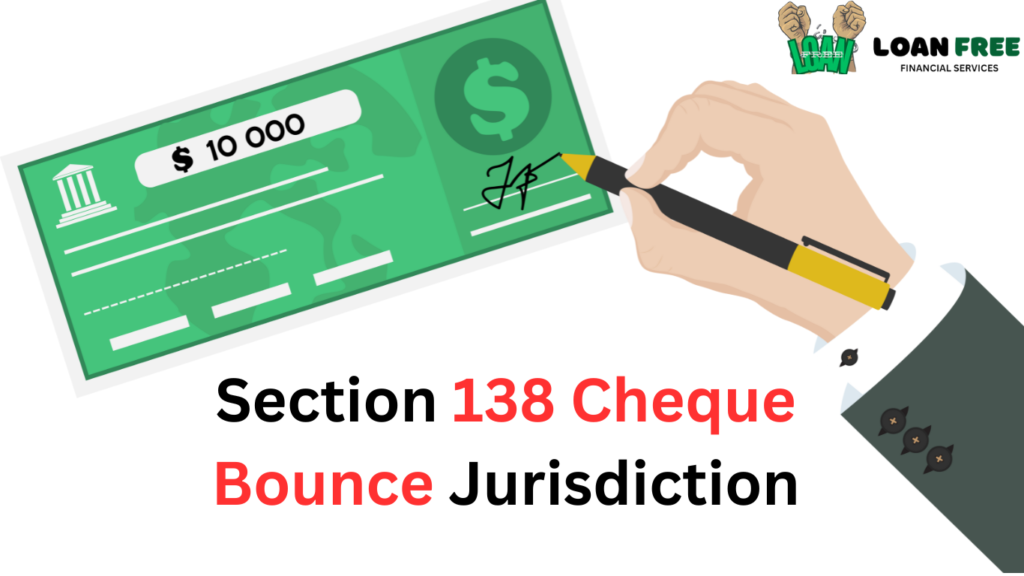138 Cheque Bounce Jurisdiction
Understanding Section 138 Cheque Bounce Jurisdiction in India.
The issue of cheque bounce has become a significant concern in India, especially in financial transactions where the credibility of a cheque is paramount. Section 138 cheque bounce of the Negotiable Instruments Act, 1881 deals with the legal framework surrounding cheque bounce cases. If a cheque is dishonored due to insufficient funds or if the amount exceeds the arrangement made by the drawer, the payee can file a case under Section 138. In this article, we’ll explore the jurisdictional aspects of cheque bounce cases under this section.

What is Section 138?
Section 138 cheque bounce of the Negotiable Instruments Act, 1881, lays down the penalties for dishonoring a cheque. If a cheque is returned unpaid by the bank due to insufficient funds or if it exceeds the funds arranged with the bank, it is considered a criminal offense. The payee, the person to whom the cheque is issued, can file a complaint in court and seek legal action.
The drawer (the person who issued the cheque) can face imprisonment for up to two years or a fine up to twice the amount of the cheque, or both. However, before any legal proceedings can begin, the payee must issue a legal notice to the drawer, giving them a 15-day window to make the payment.
Jurisdiction in Cheque Bounce Cases.
The jurisdiction, or the location where the complaint can be filed, is a crucial aspect of cheque bounce cases. The rules governing jurisdiction for such cases have evolved over time due to various court rulings.
1. Earlier Position (Before 2015):
Earlier, there was ambiguity about where the case should be filed, as the cheque could be issued in one place, presented in another, and dishonored at yet another location. As per earlier interpretations, a complaint could be filed in any of the following locations:
- The place where the cheque was drawn or issued.
- The place where the cheque was presented.
- The place where the bank dishonored the cheque.
- The place where the demand notice was sent or received.
This often led to confusion and allowed the complainant to file cases in locations inconvenient for the accused, leading to an unfair burden.
2. Supreme Court’s Bhaskaran Judgment:
In the case of K. Bhaskaran v. Sankaran Vaidhyan Balan (1999), the Supreme Court ruled that a cheque bounce complaint could be filed in any of the following jurisdictions:
- The place where the cheque was issued.
- The place where the cheque was presented for payment.
- The place where the cheque was returned due to insufficiency of funds.
- The place where the notice demanding payment was issued.
- The place where the drawer of the cheque failed to make payment within 15 days after receiving the notice.
This ruling allowed the complainant a wide choice of forums, which often caused hardships to the accused, as cases could be filed far from the accused’s place of residence or business.

3. Amendments in 2015:
To address these jurisdictional issues and reduce the misuse of the law, the Negotiable Instruments (Amendment) Act, 2015 was introduced. According to this amendment, the jurisdiction for filing a cheque bounce case was streamlined to ensure fairness for both parties. As per the 2015 amendment:
- A complaint under Section 138 can be filed only at the location of the bank branch where the cheque is presented for payment.
- If the cheque is presented in an account maintained by the payee, the case can be filed at the location of the bank branch where the payee’s bank account is located.
- If the payee presents the cheque in any other bank (a collection bank), the complaint can be filed in the court where the drawer’s bank branch is situated.
This amendment eliminated the earlier practice of forum shopping and ensured that both parties have a more predictable and convenient forum to resolve disputes.
4. Additional Clarifications:
The 2015 amendment also clarified that:
- Once a complaint is filed in a particular jurisdiction, all future complaints against the same drawer (in relation to other dishonored cheques) will be filed in the same jurisdiction, regardless of where those cheques were presented.
- If multiple cheques were issued as part of the same transaction, they would all fall under the same jurisdiction.

Conclusion
Understanding the jurisdiction for filing a cheque bounce case is crucial for both the complainant and the accused. The 2015 amendments have simplified the process, making it fairer and more efficient. The payee must now file the case in a location relevant to the bank where the cheque was presented or the drawer’s bank, providing clarity and reducing unnecessary hardships for both parties.
If you’re dealing with a cheque bounce situation, it’s essential to be aware of the jurisdictional rules to ensure the case is filed in the correct court. Always consult a legal expert to navigate the complexities of Section 138 cheque bounce and safeguard your rights effectively.
Feel free to contact us for any assistance related to cheque bounce cases or other legal matters.

Welcome To Loan Settlement Services, Provides Reliable And Personalized Solutions For Managing And Resolving Your Debt. Our Expert Team Is Dedicated To Negotiating Favorable Terms, Helping You Achieve Financial Freedom And Peace Of Mind.
SiteLinks
CONTACT INFO
Chamber Number 122 Western Wing Tis Hazari Court Delhi – 110054
- Email: advocate@loanfree.services
- Phone: +91 70425 38878
- Working Hours : Mon-Sat 9:00AM - 7:00PM
